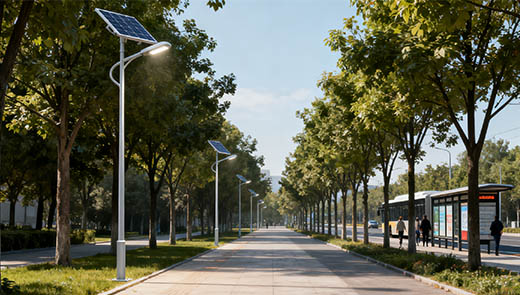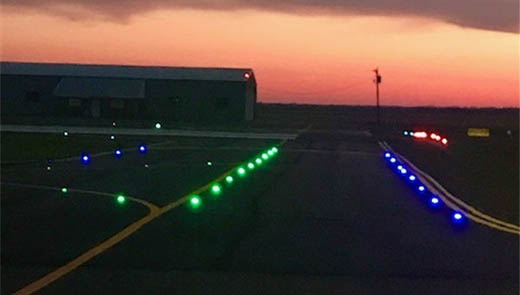Are Solar Street Lights Waterproof?
When selecting outdoor solar lighting equipment, a key question always arises: Are solar street lights waterproof? Since they are constantly exposed to rain, snow, and humid environments, their waterproof performance directly determines their durability and effectiveness. This article will provide a detailed overview of how solar street lights achieve waterproof functionality, potential issues that may arise after rain, and practical tips for protecting them.
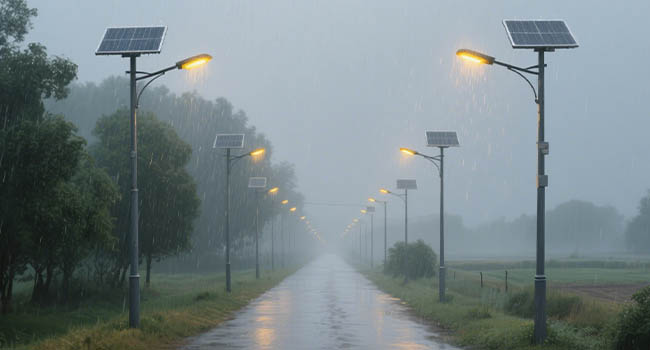
Are Solar Street Lights Designed with Waterproof Functionality?
The answer is yes: most solar street lights are designed with waterproof features to adapt to outdoor environments. Their waterproof capability is typically measured by the IP (Ingress Protection) rating, with products from well-known brands generally featuring an IP65 rating or higher. This means they can withstand dust, low-pressure water jets, and heavy rain, ensuring reliable operation under various weather conditions.
Waterproof Design of Solar Street Lights: Component Analysis
Solar panels
Solar panels use 3.2 mm thick tempered glass (light transmittance ≥91%). This glass not only has strong light transmittance but also excellent impact resistance, capable of withstanding hail, strong winds, and other external forces. The edges of the glass are filled with high-quality sealing silicone between the glass and the panel frame, forming a tight waterproof barrier to prevent rainwater from seeping in through gaps. Additionally, the tempered glass's corrosion-resistant properties ensure it remains unaffected by rainwater in long-term outdoor environments, maintaining consistent protective performance.
Controller
The controller features a fully sealed housing design, with the housing and internal components sealed by waterproof gaskets to prevent water ingress in humid environments. Some controllers are additionally equipped with bypass diodes, which prevent battery damage from overcurrent even when “hotspot effects” occur due to localized shading during rainy weather, indirectly ensuring stable operation of the controller under complex weather conditions.
Battery
The battery is typically housed in an underground waterproof compartment made of weather-resistant engineering plastic, which isolates it from surface rainwater. The compartment bottom features specially designed inclined drainage holes to promptly expel any moisture that may enter, preventing water accumulation and battery immersion. Prior to shipment, the battery compartment undergoes rigorous water immersion testing to ensure long-term waterproof integrity.
Light Pole
The light pole is made of high-strength steel, with the surface first undergoing hot-dip galvanization to form a dense zinc layer, effectively preventing direct contact between rainwater and the steel to avoid corrosion. An outdoor-specific powder coating is applied over the galvanized layer. This coating has strong adhesion and resistance to UV aging, further enhancing corrosion resistance. Combined with a sturdy flange base for secure mounting, the light pole can withstand winds up to 12 on the Beaufort scale, ensuring structural stability during heavy rain and other adverse weather conditions.
LED Light Source
The LED light source itself adopts a sealed module design, with the LED chips and circuit board encapsulated within a waterproof housing. The reflector is manufactured using vacuum ion plating technology, which not only improves light reflection efficiency but also forms a wear-resistant, waterproof protective layer on the surface, preventing direct erosion of the reflective layer by rainwater. Some high-end products feature a dual-sealed structure for the lamp head, with waterproof gaskets added at the connection points between the housing and lamp body, further enhancing waterproof performance and ensuring IP65-rated protection.
Most lamp heads adopt a dual-sealed design compliant with IP65 standards. The battery compartment uses 120-micron-thick sealed silicone rubber to provide insulation and prevent moisture ingress.
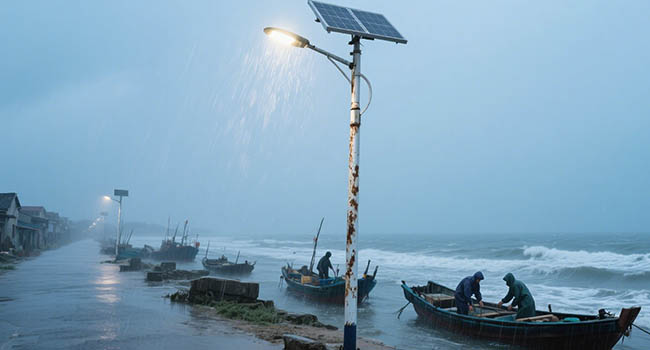
Why Solar Street Lights May Not Work After Rain
Water Ingress
Specific Situation: Poor manufacturing processes (such as poor sealing performance) or wear and tear from long-term use may cause water to seep into the circuitry or even the battery during heavy rain.
Solution: Inspect the housing for cracks or gaps, use a soft cloth to dry the internal components, and ensure no moisture remains; apply waterproof sealant to reinforce the seal, and replace the seal if severely damaged; select products with an IP65 rating or higher to prevent recurrence.
Insufficient Sunlight
Specific Situation: Cloudy or rainy weather can block 10%-25% of sunlight, resulting in insufficient battery charging. If installed in a shaded area, the issue will be more severe.
Solution: Install the solar light in a well-lit location, avoiding obstructions such as trees or walls; adjust the angle of the solar panels seasonally to maximize sunlight exposure; In rainy regions, upgrade to larger solar panels or models with dual solar and USB charging functionality.
Dirty Solar Panels
Specific Situation: Rainwater carries dust, pollen, bird droppings, and other particles from the air onto the solar panel surface, forming a layer of grime. These impurities block sunlight, reducing the panel's photovoltaic conversion efficiency, resulting in slower charging speeds and shorter battery life. In dusty industrial areas or along roadsides, dirt accumulates faster, especially after rain, when moisture causes impurities to adhere firmly to the panels, further impairing light absorption.
Solution: Clean the panels every 3-6 months using a soft cloth dampened with mild soapy water. Avoid using hard-bristled brushes or corrosive cleaners to prevent surface scratches. In dusty environments, increase the cleaning frequency to ensure the panels remain transparent.
Battery Issues
Specific circumstances: The lifespan of solar street light batteries is typically 1-2 years. Water ingress or prolonged undercharging can accelerate aging. Moisture can cause battery electrode corrosion and internal short circuits, while frequent undercharging can lead to rapid capacity degradation, resulting in shorter lighting times or complete malfunction. If the battery protection tab is not removed from new lights, it may prevent charging, which is a common installation oversight.
Solution: Disassemble the fixture to inspect the battery. If corrosion or leakage is detected, replace it immediately. It is recommended to use high-quality nickel-metal hydride or lithium-ion batteries, which can last 3-5 years with proper maintenance. Ensure the battery protection tab is removed during new light installation to enable normal charging.
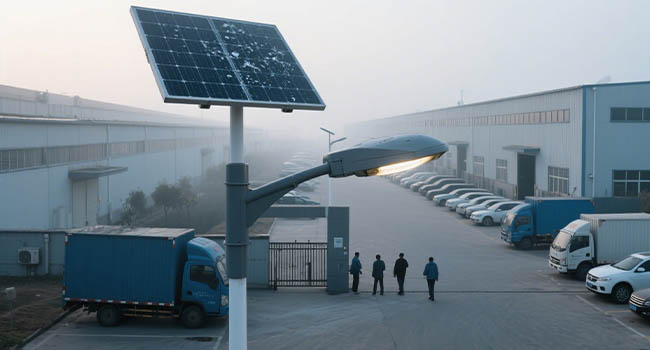
Sensor Malfunctions
Specific Situation: Rainwater and dust may adhere to the surface of the light or motion sensors, obstructing their sensing areas, causing the sensors to misjudge the ambient brightness, resulting in situations where the lights should turn on but do not, or should turn off but do not. Prolonged moisture may also affect the internal circuits of the sensors, causing component damage and complete loss of functionality.
Solution: Wipe the sensor surface with a soft cloth to remove moisture and dirt. Then cover the sensor with a dark cloth to simulate nighttime conditions. If it still does not light up, the sensor may be faulty, and you should contact the manufacturer to replace the component. Avoid obstructing the sensor and keep the sensing area clean in daily use.
How Long Can Solar Street Lights Be Exposed to Rain?
Short-Term Exposure
For high-quality solar street lights that meet IP65 and above protection standards, they can usually work stably for more than 1 week in continuous rainfall environment (including moderate to heavy rain). The sealing structure, waterproof tape and drainage design can effectively prevent rainwater from penetrating into the internal core components, ensuring that the circuitry, battery and LED light source are not affected.
Long-Term Exposure
Even street lights with a high level of protection can suffer potential problems due to long-term humidity buildup if they are subjected to weeks of rainy weather or severe conditions such as strong winds or hail. For example, seals may gradually deteriorate due to repeated exposure to moisture, trace water vapor in the battery compartment may affect the battery performance, and the joints of the light poles may accelerate rust and corrosion due to prolonged wetness. Therefore, after prolonged rainfall, it is important to check the sealing condition of the street light, the battery level and the electrical circuitry in a timely manner.
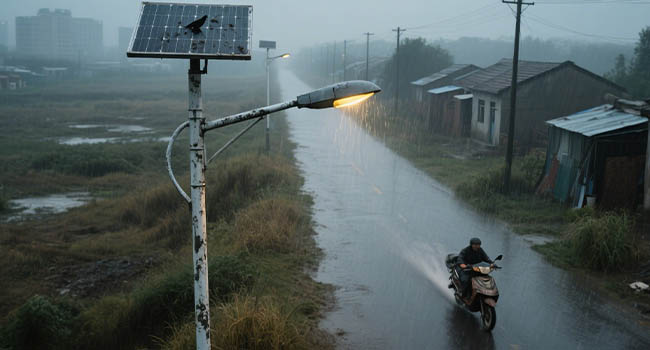
How to Protect Outdoor Solar Street Lights from Rain
If you want to extend the service life of solar street lights and reduce the loss caused by rain, you can start from the aspects of selection, maintenance and installation:
Prioritize Products with High Protection Level
When purchasing, not only should you pay attention to the waterproof rating of IP65 and above, but also pay attention to the details of the material - for example, whether the pole is made of hot-dip plating or not, or whether the light pole is made of hot-dip plating or not. - For example, whether the pole is hot dip galvanized + powder coated, whether the battery box is made of weather-resistant engineering plastics, and whether the sealing strip is made of ageing-resistant silicone. These details directly determine the durability of the street lights in rainy environments.
Carry out Regular Targeted Maintenance
Every 1-3 months, check the key parts of the street lights: whether there are cracks in the sealing joints or whether the adhesive strips are peeling off, and repair them in time with waterproof silicone; whether the drainage holes of the battery compartment are blocked, to ensure that the accumulated water can be discharged without any problem; and whether there is any corrosion in the interface between the light head and the pole, and an antirust agent can be applied to prevent corrosion. Before the rainy season, it is recommended to comprehensively check all sealing parts once and replace the aging seals in advance.
Scientific Installation to Avoid the Risk of Water Accumulation
When installing the street light, avoid areas prone to water accumulation, such as low-lying areas, near drainage ditches or under roof outlets, and make sure that the street light base is at least 10 centimeters higher than the ground, so as to reduce the probability of the base being immersed in rainwater. At the same time, the solar panels should be installed at a slightly tilted angle (usually 30°-45° from the ground) to ensure the efficiency of light absorption and to allow rainwater to flow down the panels, reducing the residual water on the surface.
Extra Protection under Extreme Weather
Before the arrival of extreme weather such as typhoons and rainstorms, if conditions permit, the power supply of the street light can be temporarily turned off to avoid short-circuiting of circuits due to rainwater infiltration under the impact of strong currents; for the street light installed in the area of low terrain, small water retaining slopes can be piled up around the base or the lamp head can be temporarily covered with a waterproof cover (pay attention to reserving space for heat dissipation). If the local winter is rainy and the temperature is low, you also need to check whether the battery has a low-temperature protection function, so as to avoid cracking the battery compartment after the rainwater freezes.
Solar street lights are designed to be waterproof, with IP65 and above protection levels and specialized components designed to ensure their resistance to rain and humidity. By understanding their waterproof properties, dealing with problems that arise after rain and following maintenance tips, you can ensure that your solar street lights will work reliably for a long time in all kinds of harsh weather conditions.


